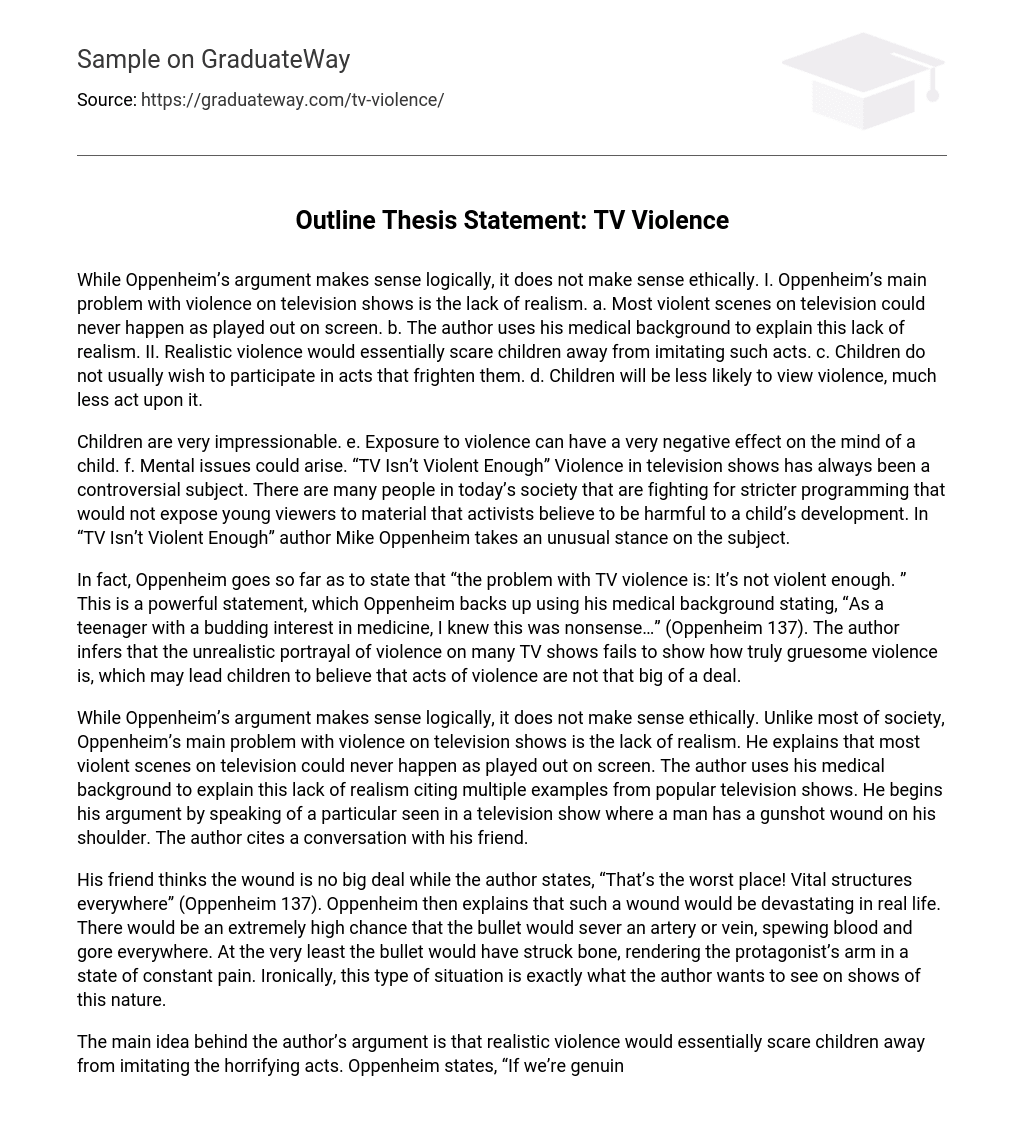While Oppenheim’s argument makes sense logically, it does not make sense ethically. I. Oppenheim’s main problem with violence on television shows is the lack of realism. a. Most violent scenes on television could never happen as played out on screen. b. The author uses his medical background to explain this lack of realism. II. Realistic violence would essentially scare children away from imitating such acts. c. Children do not usually wish to participate in acts that frighten them. d. Children will be less likely to view violence, much less act upon it.
Children are very impressionable. e. Exposure to violence can have a very negative effect on the mind of a child. f. Mental issues could arise. “TV Isn’t Violent Enough” Violence in television shows has always been a controversial subject. There are many people in today’s society that are fighting for stricter programming that would not expose young viewers to material that activists believe to be harmful to a child’s development. In “TV Isn’t Violent Enough” author Mike Oppenheim takes an unusual stance on the subject.
In fact, Oppenheim goes so far as to state that “the problem with TV violence is: It’s not violent enough. ” This is a powerful statement, which Oppenheim backs up using his medical background stating, “As a teenager with a budding interest in medicine, I knew this was nonsense…” (Oppenheim 137). The author infers that the unrealistic portrayal of violence on many TV shows fails to show how truly gruesome violence is, which may lead children to believe that acts of violence are not that big of a deal.
While Oppenheim’s argument makes sense logically, it does not make sense ethically. Unlike most of society, Oppenheim’s main problem with violence on television shows is the lack of realism. He explains that most violent scenes on television could never happen as played out on screen. The author uses his medical background to explain this lack of realism citing multiple examples from popular television shows. He begins his argument by speaking of a particular seen in a television show where a man has a gunshot wound on his shoulder. The author cites a conversation with his friend.
His friend thinks the wound is no big deal while the author states, “That’s the worst place! Vital structures everywhere” (Oppenheim 137). Oppenheim then explains that such a wound would be devastating in real life. There would be an extremely high chance that the bullet would sever an artery or vein, spewing blood and gore everywhere. At the very least the bullet would have struck bone, rendering the protagonist’s arm in a state of constant pain. Ironically, this type of situation is exactly what the author wants to see on shows of this nature.
The main idea behind the author’s argument is that realistic violence would essentially scare children away from imitating the horrifying acts. Oppenheim states, “If we’re genuinely interested in protecting our children, we should stop campaigning to clean up TV violence” (Oppenheim 141). This idea makes sense to an adult for the same reason that most people will never go skydiving; it looks frightening when they watch videos of it, therefore they never intend to try it. Children do not usually wish to participate in acts that frighten them which is why Oppenheim’s argument seems to make sense.
He believes that if children were shown the “real deal” when it comes to violence, perhaps they will be less likely to view it, much less act upon it. The problem with the author’s argument is that children are very impressionable. Oppenheim believes that the violent acts should be shown with all the blood, pain, and gore that would occur in a real-life situation. Exposure to these types of situations, however, has been shown to have very negative effects on the mind of a child. These effects may not surface until later in life.
Depression, suicidal thoughts, or any other number of mental issues could arise from watching such terrible scenes at such a young age. In Mark Oppenheim’s “TV Isn’t Violent Enough” he makes the argument that the violence portrayed on television shows is not nearly graphic enough. He hopes to persuade readers that exposing children to graphic violence will lead them away from violent behavior by making them frightened of it. However, Oppenheim fails to take into account the fragile psyche of a young child and just how impressionable it can be.





